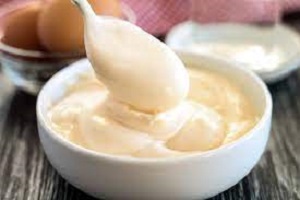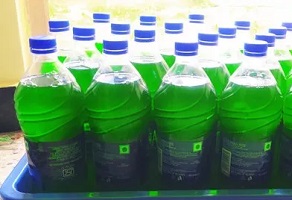How To Make Mayonnaise at Home With/Without Blender?
How To Make Mayonnaise At Home with eggs – With/Without Blender?

This Homemade Mayonnaise Recipe is reliable and produces the best-tasting mayonnaise ever!
It is ideal for many dishes, including salads, sandwiches, and dips. Anywhere you would use store-bought mayonnaise; you can use this homemade version.
This versatile condiment known as mayonnaise or mayo is frequently used as a spread or dip for salads, sandwiches, shawarma, chicken burgers, beef burgers, and similar foods.
It is a necessity in my home because I also use it as a beauty and hair product. But I always make my own mayonnaise at home rather than rushing out to the store whenever I run out.
You won’t believe how easy it is to prepare; all you need are 3 ingredients you might already have in your pantry and it is healthier too, as you know what goes into it.
Why You Should Make Mayonnaise at Home
I can’t even begin to count how many times I’ve used this mayonnaise recipe. You are in for a treat if you have never tried making your own mayonnaise.
Homemade mayo is incredibly creamy and tasty compared to store-bought varieties.
The reason why I adore this recipe so much is as follows:
- Our recipe uses whole eggs as an alternative to just the yolks so you can skip separating the eggs.
- The remaining ingredients are easy to get and very likely in your kitchen right now.
- Then, the whole process takes less than 10 minutes
- Lastly, you can add extra ingredients for more flavor (such as roasted garlic or herbs).
I’ve shared suggestions below:
Two Key Advice for Making Homemade Mayonnaise in Nigeria
Getting the egg and oil to emulsify is the key to making mayo. You’ll be left with a depressing, runny mess if they don’t.
That is clearly not what we want! To ensure that your mayo emulsifies, you MUST complete the following two things:
1st
Use an egg that is at room temperature. Please refrain from removing an egg from your refrigerator and attempting to create mayonnaise with it.
It might work if you’re lucky, but the odds are against it. Avoid taking a chance. Place the egg in a glass, then fill the glass with hot tap water to warm it. It will be ready to use in five minutes.
2nd
Combine an acid with the whisked egg yolk. Lemon juice works well as an acid, but vinegar also helps.
The reason is, that acid starts to break down the proteins in the egg yolk, allowing for better emulsification.
Whisk the egg yolks and lemon juice very well before you begin adding the oil.
You will never find a better homemade mayonnaise recipe than this one.
The mayo has a nice custardy texture, is creamy, and is the perfect amount of sour.
It is so mouth-wateringly good that you’ll want to put it on everything
Get the Recipe!
Ingredients for Homemade Bama Mayonnaise
- Makes about 1 cup of Mayonnaise
- 1 large Egg (at room temperature)
- 150ml Vegetable oil of choice ( not necessary to use olive oil)
- 1 tablespoonful of Lemon juice or Vinegar (optional, but gives it a slightly acidic taste)
- ¼ teaspoon salt (or to taste)
Please Note:
If you want to, you can also add herbs and spices to your mixture.
Use any other vegetable oil if you choose; olive oil gives it a flavor that most people don’t like.
Each ingredient needs to be at room temperature.
Mayonnaise can be made in two different ways. We make it entirely by hand, but an immersion blender or food processor with a small bowl attachment can also be used.
(If you decide to carry it out by hand, be prepared for sore arms and strong biceps
Method
- Firstly, wash the egg thoroughly and break it into a blender.
2. Then, add the salt, vegetable oil, and lemon juice/Vinegar and blend the mixture for about 10 seconds and stop when you see the mixture turning slightly white.
Essential Tip: if you don’t have an immersion hand blender, you have to add the oil slowly until you get your desired consistency. - Thirdly, continue blending for another 20 seconds till all the ingredients are well combined.
If you’re using an immersion blender, do an upwards and downwards movement until the oil is well combined with the egg.
You will notice a stiff and smooth consistency. - Lastly pour into a sterile container and that’s it! Your homemade mayonnaise is ready for use.
To Make Mayonnaise with a Hand Whisk (by hand), No blender is needed
Mayonnaise can also be made with a common hand whisk, but in place of using the whole egg, only the yolk will be used here.
Ingredients
- 1 egg Yolk
- 120ml Vegetable oil
- 2 tablespoons vinegar or lemon juice
- Salt to taste
Method
- After washing, cracking, and separating the yolk from the white with care, place the egg in a large basin.
Add the salt to the egg yolk and mix together until well combined.
- Secondly, using a teaspoon, add the oil very slowly (drop by drop), stirring constantly.
When you add the oil, the mayonnaise will start to thicken. If the mixture starts to get too thick, add a few drops of the vinegar/lemon juice to thin it out a bit.
Stir the mixture again until it is smooth and the consistency you want.
- Add the remaining vinegar/lemon juice and stir until smooth and well combined.
Although homemade mayonnaise can be stored for up to a week, I strongly advise using it within three days and storing it in the refrigerator.
Quick notes and suggestions
If you accidentally made a thin (watery) mayonnaise, don’t throw it away. Instead, whisk 1 egg yolk in a second bowl until it becomes frothy before gradually adding the thin mayonnaise and whisking constantly until the necessary thickness is reached.
– For a thicker mayonnaise when using the blender method, beat the egg first until stiff before gently whisking in the oil and lemon juice.
– At all times use fresh eggs.
– Eggs from pastured hens are best used for mayonnaise since they contain 20 times more healthy omega-3 fatty acids than factory-fed hens.
FAQs
How do you make mayonnaise cream?
It is prepared by gradually incorporating oil into an egg yolk while vigorously whisking to evenly distribute the oil.
Lecithin and protein from the yolk serve as the emulsifiers that stabilize the emulsion while the oil and water in the yolk serve as its base.
What is homemade mayonnaise made of? The Five Steps for Making Mayonnaise
Firstly, add an egg to the bowl of your food processor and process for about 20 seconds. Then, add mustard, vinegar, and salt then process for another 20 seconds.
After that, add the oil gradually, a few drops at a time, up to roughly a fourth of the total amount. Adding the oil gradually is very vital.
What are the 6 steps to making mayonnaise?
Let’s get started!
- Step 1: Ingredients. You will need
- Step 2: Preparing for Emulsification. Mayonnaise is made up primarily of two ingredients that don’t play nicely with one another: lemon juice and oil
- Step 3: Separating the Egg
- Step 4: Adding It All Together
- Step 5: Adding Oil
- Step 6: Et Voila!
Is it safe to make your own mayo?
Due to the potential presence of Salmonella germs, the United States Department of Agriculture does not advise consuming uncooked or undercooked raw shell eggs.
However, if raw, in-shell pasteurized eggs or pasteurized egg products are used, homemade mayonnaise can be made without risk
How is real mayonnaise made?
Egg yolks and vinegar or lemon juice are combined to make mayonnaise.
A thick, creamy sauce or dressing known as mayonnaise is created by combining oil, egg yolks, vinegar or lemon juice, and seasonings.
It differs from salad dressing, which is often sweeter than mayonnaise and does not contain egg yolks.
Is mayonnaise made with milk?
Although most mayo does not include milk, it is frequently mistaken for dairy.
Instead, a combination of spices, egg yolks, and lemon juice or vinegar is used to make the majority of commercial types of mayo.
Therefore, those who follow a dairy-free diet can consume mayo in most forms.
Which oil works best for the mayonnaise?
Canola, grapeseed, peanut, and safflower oils all work well. Ensure that the oil and egg are both at the same temperature.
Although you can use cold oil and eggs, I found that working with room temperature oil and eggs was the most convenient.
What is the shelf life of homemade mayonnaise?
2 weeks
Making your own mayonnaise from home can really change your life.
While I have nothing against the shelf-stable, store-bought counterpart, handmade food is genuinely unmatched in terms of flavor and texture.
It only takes a few minutes to whisk up in the food processor and keeps for up to two weeks in the refrigerator.
Why is my mayo not thickening?
Two tablespoons of boiling water should be whisked in if your mayonnaise is broken and divided, or if it’s still a little thin after the initial whisking.
The hot water will aid in the components coming back together by assisting the yolks in setting and re-emulsifying with the oil.
Why is the mayo I made at home bitter? Homemade mayo bitter
Not all oils are made equal for preparing mayo.
Although olive oil and extra-virgin olive oil are functional, they sometimes have a strong flavor that makes mayo seem bitter and unpleasant.
Use this advice:
Choose an oil that is more neutral, such as safflower, canola, or vegetable oil.
How is mayonnaise thickened?
“To thicken your mayonnaise, firstly bring two teaspoons of water to a boil and whisk in the egg yolk,”.
“Then, as you whisk, begin adding in your already-prepared mayonnaise, and continue whisking until you’ve reached your preferred thickness.”
Is eating mayo healthy?
The high vitamin E content of mayonnaise keeps the heart healthy and robust and reduces the risk of stroke.
Omega-3-rich mayonnaise provides significant heart-health benefits.
Why is it OK to eat raw eggs in mayo?
Mayonnaise, Hollandaise, and Caesar Salad dressings contain raw eggs which can carry salmonella bacteria.
Even if pasteurized eggs are safer, what if there isn’t a store nearby that offers them?
Food is heated to 140°F during pasteurization, which kills hazardous germs.
Can mayonnaise go bad?
Or does mayonnaise spoil? A jar of mayo will keep in the pantry for approximately three months before being opened.
Be aware that jars should be refrigerated and used within two months if they have just been opened.
Are raw eggs used in mayo?
Mayonnaise is typically produced with raw egg yolks, which many chefs would rather not use.
Alternative methods recommend creating mayonnaise with hard-cooked eggs or even a milk-based eggless mayo.
How is industrial mayonnaise made? Which equipment is required for making mayonnaise?
A metal bowl, a whisk, strong hands, and patience are necessary for the traditional method of making mayonnaise.
As an alternative, I advise using a mixer to make homemade mayonnaise.
We could also use a blender, but the sauce would come out harder and less airy.
Why is the mayo I make at home so yellow?
This is how homemade mayonnaise turns yellow due to the pigments in egg yolks (primarily xanthophylls).
On the other hand, store-bought mayonnaise is devoid of egg yolks. It is created by blending proteins, emulsifiers, and oil (usually whey proteins).
Is mayo Healthy fat?
While almost all of the fat in mayo is unsaturated, which is a healthier fat? What ingredients are in eggless mayonnaise?
Mayonnaise is typically created using eggs, oil, vinegar, and mustard. However, eggless mayo is also available in the market. You may make mayonnaise without eggs by using milk, aquafaba, or soy milk.
Can I substitute curd for the mayonnaise?
Here’s a tip we frequently use to replace mayo: use Greek yogurt in place of ½ to 2/3 of the original amount of mayo!
Greek yogurt keeps the recipe creamy while reducing the number of calories.
This is excellent in salads with mayonnaise, such as classic tuna, egg, or shrimp salad.
What is the purpose of the vinegar in mayonnaise -Why is vinegar used in mayonnaise?
One of the chemicals that are most frequently utilized to create an antibacterial barrier is vinegar.
It is the most popular acid used to preserve mayonnaise since it has antibacterial properties and aids in preventing rancidity and deterioration.
How long would homemade mayonnaise last in the refrigerator?
However, it takes very little planning to make a batch, and the mayo keeps for two weeks in the refrigerator.
Why does my homemade mayonnaise taste oily?
Depending on how much mayonnaise you use in your household, whipping up a 1/2 cup of mayonnaise can be a daily activity or it might last you its whole 2-week shelf life.
Why does my homemade mayonnaise taste oily?
Reason: Not enough water is present to suspend and separate the oil droplets. Solution: Add 5–10 ml (1–2 tablespoons) of water, vinegar, or lemon juice right away.
The mayonnaise will lose its oily appearance and thin out a little. At this point, you can add any extra oil.
Is making your own mayonnaise less expensive?
Of two really cheap options, homemade is the more affordable. Little benefit from homemade
How many eggs are in a jar of mayo?
027 eggs and each 30oz jar have 1.613 eggs.
Is homemade mayonnaise healthier than store-bought?
While it does have about 90 calories per tablespoon, it can be made with healthy fats.
Furthermore, some store-bought mayo contains extra sugar. You won’t have to be concerned about what might be inside if you make your own in only five minutes!
Can you over whisk mayonnaise?
The straightforward reality is that you must whisk vigorously and pour slowly. The emulsion will break if you pour too much too rapidly, leaving you with what appears to be scrambled eggs floating in an oil slick.
Why is my mayonnaise too runny?
In conclusion, either the components haven’t been appropriately dosed or cold ingredients have been utilized, which are the two main causes of mayonnaise that doesn’t set or is too runny.
In either case, do not panic – you still have time to preserve your sauce.
Which mayonnaise is the healthiest?
The healthiest mayo from Spectrum is their organic mayo with flax seed.
Although it contains soybean oil, if you don’t have a problem with soy, this is a wonderful option because it is organic and doesn’t include any odd additives.
Can mayonnaise lead to belly fat gain?
“Mayonnaise is one of the culinary condiments with the highest fat and calorie content.
Additionally, it’s high in sodium, which contributes to weight gain.” One tiny tablespoon of mayo contains 90 calories and 10 grams of fat.
Which is worse, ketchup or mayo?
Ketchup contains far fewer calories per tablespoon and no fat when compared to its rival mayonnaise (mayo contains 103 calories, 12 grams of fat)
As a result, it is a better option for individuals trying to reduce extra calories. Lycopene levels in processed and cooked tomatoes were also found to be very high.
Can I freeze mayonnaise?
Although it’s not common, mayonnaise can always be frozen to extend its shelf life.
Mayo is an emulsion, thus there’s a good likelihood that freezing it will lead to the components disintegrating.
Additionally, the components could separate and look less than appealing.
How do you tell if mayonnaise has gone bad?
How to Tell If Mayonnaise Is Spoilt
- If you see any organic growths inside the jar, like mold or spores.
- Perceive off, acidic, or putrid smell.
- Notice a change of color, like a darker shade of white or brownish-yellow.
- Off taste.
Should mayo be refrigerated?
Mayonnaise:
You can purchase mayonnaise from a shelf without a refrigerator, but you must store it in the fridge as soon as you open it.
In fact, if opened mayo is exposed to a temperature of 50 degrees or above for more than eight hours, the USDA advises tossing it in the trash
Can you boil mayonnaise?
You can warm it successfully if you do so on a low, constant heat and take care not to overheat it.
The most popular condiment in the world is definitely mayo.
Is mustard present in mayonnaise?
Oil, an emulsifier (egg yolk is recommended in some countries), vinegar (which acts as a pH regulator and taste), spices, seasonings (sugar, salt, mustard…), and stabilizers (thickeners for mayo with less than 70% oil only) are the typical elements found in mayo.
What is mayonnaise made of?
- Mayonnaise Ingredients
The ingredients to make mayo are simple – we bet you even have them in your kitchen right now.
So, what’s in my mayo recipe?
- Avocado oil
- Egg
- Lemon juice
- White wine vinegar
- Dijon mustard
- Sea salt
How to Make Mayonnaise – Homemade Mayo Recipe
The Five Steps for Making Mayo
- Firstly, prepare your food processor. It’s very convenient to use the small bowl attachment that came with the food processor to make mayo.
- Then, add an egg to the bowl of your food processor and process for about 20 seconds.
- After that, add the mustard, vinegar, and salt then process for another 20 seconds.
- Slowly and carefully, add the oil, in tiny drops, until about a quarter of the oil has been added. Adding the oil slowly is important. If you were to dump it all in at once, you’d have mayo thicker than soup!
- Lastly, taste the mayo and adjust with additional salt and vinegar or lemon juice.
Is mayo prepared with yolks or whites of eggs?
It’s created with egg *yolks*, salt, vinegar, oil, and a smidgeon of crushed mustard. Mayo made at home has a slight yellow tint to it.
Others claimed that because egg yolks are the main element in mayo, they should be yellow
Is mayo made using uncooked/raw eggs?
Mayo produced at home is made using raw eggs that aren’t boiled. However, if raw, in-shell pasteurized eggs or pasteurized egg products are used, homemade mayo can be made safely.
Is mayo made with milk? What is vegan mayonnaise/eggless mayo made of
Using pantry staples, you can make vegan mayo.
To prepare this recipe, soaked cashews are combined with apple cider vinegar, dijon mustard (or dried mustard powder), sugar, salt, and pepper, as well as a pinch of turmeric for color
What is the function of the egg yolk in mayo?
The egg yolk not only adds richness to the mayo, but also functions as an emulsifier, ensuring that the oil and water in the sauce are evenly distributed and blended.
Whipping the yolk before adding the oil allows the sauce to include some air right away, preventing it from becoming overly dense.
What is the purpose of egg yolk in mayo? Why is egg yolk used in mayo?
Mayo, like other emulsions, has an emulsifier…in this case, the amazing, edible egg. The phospholipid lecithin is found in egg yolks.
As a result, half of the lecithin dissolves in water, while the other half dissolves in oil. As a result, oil droplets can be dissolved in vinegar to make mayo


